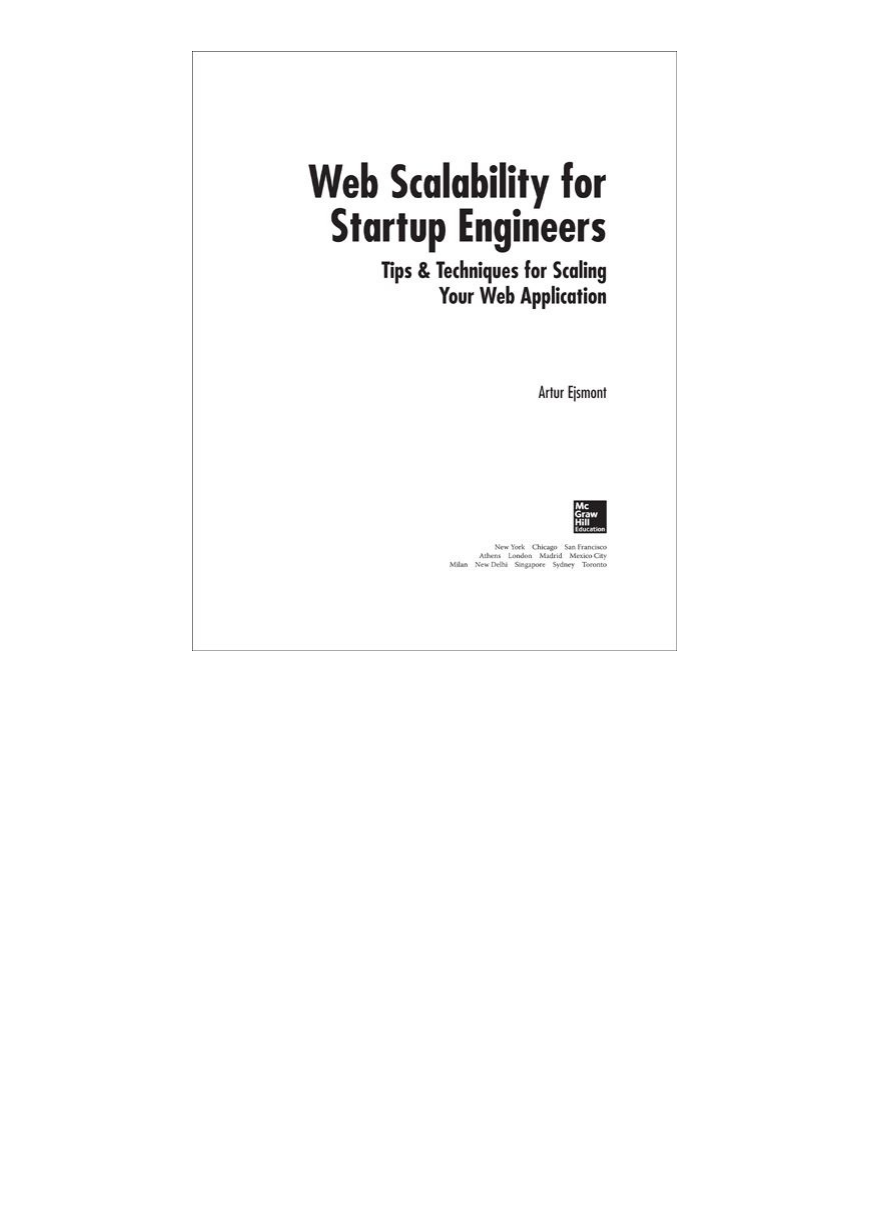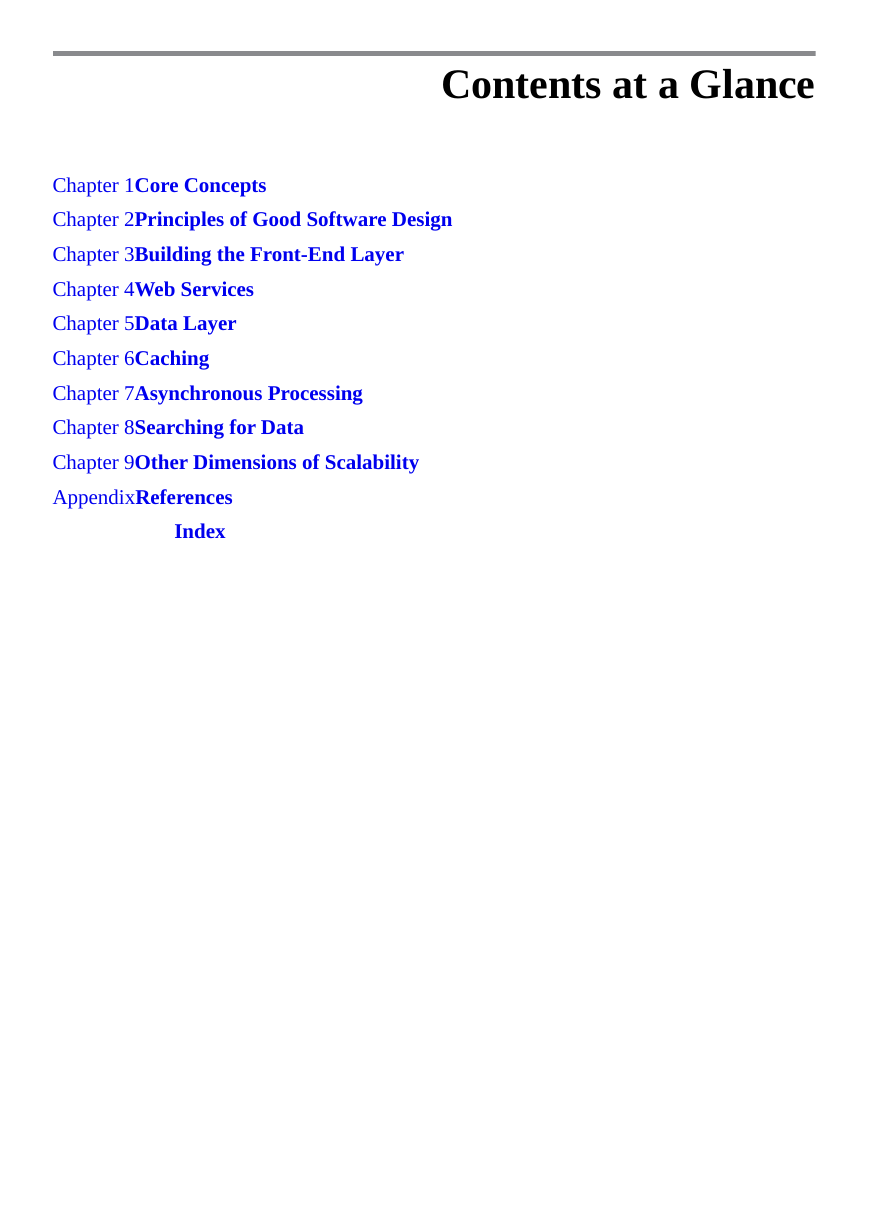Title Page
Copyright Page
About the Author
Dedication
Contents at a Glance
Contents
Acknowledgments
Introduction
Chapter 1 Core Concepts
What Is Scalability?
Evolution from a Single Server to a Global Audience
Single-Server Configuration
Making the Server Stronger: Scaling Vertically
Isolation of Services
Content Delivery Network: Scalability for Static Content
Distributing the Traffic: Horizontal Scalability
Scalability for a Global Audience
Overview of a Data Center Infrastructure
The Front Line
Web Application Layer
Web Services Layer
Additional Components
Data Persistence Layer
Data Center Infrastructure
Overview of the Application Architecture
Front End
Web Services
Supporting Technologies
Summary
Chapter 2 Principles of Good Software Design
Simplicity
Hide Complexity and Build Abstractions
Avoid Overengineering
Try Test-Driven Development
Learn from Models of Simplicity in Software Design
Loose Coupling
Promoting Loose Coupling
Avoiding Unnecessary Coupling
Models of Loose Coupling
Don’t Repeat Yourself (DRY)
Copy and Paste Programming
Coding to Contract
Draw Diagrams
Use Case Diagrams
Class Diagrams
Module Diagrams
Single Responsibility
Promoting Single Responsibility
Examples of Single Responsibility
Open-Closed Principle
Dependency Injection
Inversion of Control (IOC)
Designing for Scale
Adding More Clones
Functional Partitioning
Data Partitioning
Design for Self-Healing
Summary
Chapter 3 Building the Front-End Layer
Managing State
Managing HTTP Sessions
Managing Files
Managing Other Types of State
Components of the Scalable Front End
DNS
Load Balancers
Web Servers
Caching
Auto-Scaling
Deployment Examples
AWS Scenario
Private Data Center
Summary
Chapter 4 Web Services
Designing Web Services
Web Services as an Alternative Presentation Layer
API-First Approach
Pragmatic Approach
Types of Web Services
Function-Centric Services
Resource-Centric Services
Scaling REST Web Services
Keeping Service Machines Stateless
Caching Service Responses
Functional Partitioning
Summary
Chapter 5 Data Layer
Scaling with MySQL
Replication
Data Partitioning (Sharding)
Scaling with NoSQL
The Rise of Eventual Consistency
Faster Recovery to Increase Availability
Cassandra Topology
Summary
Chapter 6 Caching
Cache Hit Ratio
Caching Based on HTTP
HTTP Caching Headers
Types of HTTP Cache Technologies
Scaling HTTP Caches
Caching Application Objects
Common Types of Object Caches
Scaling Object Caches
Caching Rules of Thumb
Cache High Up the Call Stack
Reuse Cache Among Users
Where to Start Caching?
Cache Invalidation Is Difficult
Summary
Chapter 7 Asynchronous Processing
Core Concepts
Synchronous Example
Asynchronous Example
Shopping Analogy
Message Queues
Message Producers
Message Broker
Message Consumers
Messaging Protocols
Messaging Infrastructure
Benefits of Message Queues
Enabling Asynchronous Processing
Easier Scalability
Evening Out Traffic Spikes
Isolating Failures and Self-Healing
Decoupling
Message Queue–Related Challenges
No Message Ordering
Message Requeueing
Race Conditions Become More Likely
Risk of Increased Complexity
Message Queue–Related Anti-Patterns
Treating the Message Queue as a TCP Socket
Treating Message Queue as a Database
Coupling Message Producers with Consumers
Lack of Poison Message Handling
Quick Comparison of Selected Messaging Platforms
Amazon Simple Queue Service
RabbitMQ
ActiveMQ
Final Comparison Notes
Introduction to Event-Driven Architecture
Request/Response Interaction
Direct Worker Queue Interaction
Event-Based Interaction
Summary
Chapter 8 Searching for Data
Introduction to Indexing
Modeling Data
NoSQL Data Modeling
Wide Column Storage Example
Search Engines
Introduction to Search Engines
Using a Dedicated Search Engine
Summary
Chapter 9 Other Dimensions of Scalability
Scaling Productivity through Automation
Testing
Build and Deployment
Monitoring and Alerting
Log Aggregation
Scaling Yourself
Overtime Is Not a Way to Scale
Managing Yourself
Scaling Agile Teams
Adding More People
Procedures and Innovation
Culture of Alignment
Summary
Appendix References
Books
White Papers
Talks
Links
Index
















 2023年江西萍乡中考道德与法治真题及答案.doc
2023年江西萍乡中考道德与法治真题及答案.doc 2012年重庆南川中考生物真题及答案.doc
2012年重庆南川中考生物真题及答案.doc 2013年江西师范大学地理学综合及文艺理论基础考研真题.doc
2013年江西师范大学地理学综合及文艺理论基础考研真题.doc 2020年四川甘孜小升初语文真题及答案I卷.doc
2020年四川甘孜小升初语文真题及答案I卷.doc 2020年注册岩土工程师专业基础考试真题及答案.doc
2020年注册岩土工程师专业基础考试真题及答案.doc 2023-2024学年福建省厦门市九年级上学期数学月考试题及答案.doc
2023-2024学年福建省厦门市九年级上学期数学月考试题及答案.doc 2021-2022学年辽宁省沈阳市大东区九年级上学期语文期末试题及答案.doc
2021-2022学年辽宁省沈阳市大东区九年级上学期语文期末试题及答案.doc 2022-2023学年北京东城区初三第一学期物理期末试卷及答案.doc
2022-2023学年北京东城区初三第一学期物理期末试卷及答案.doc 2018上半年江西教师资格初中地理学科知识与教学能力真题及答案.doc
2018上半年江西教师资格初中地理学科知识与教学能力真题及答案.doc 2012年河北国家公务员申论考试真题及答案-省级.doc
2012年河北国家公务员申论考试真题及答案-省级.doc 2020-2021学年江苏省扬州市江都区邵樊片九年级上学期数学第一次质量检测试题及答案.doc
2020-2021学年江苏省扬州市江都区邵樊片九年级上学期数学第一次质量检测试题及答案.doc 2022下半年黑龙江教师资格证中学综合素质真题及答案.doc
2022下半年黑龙江教师资格证中学综合素质真题及答案.doc